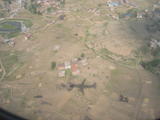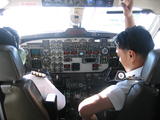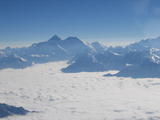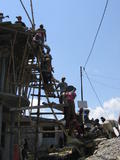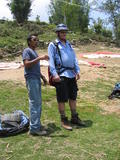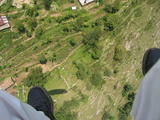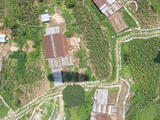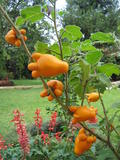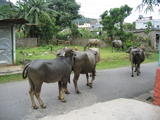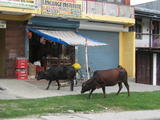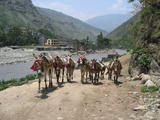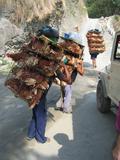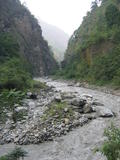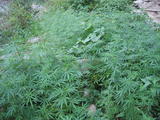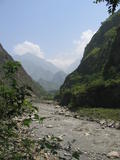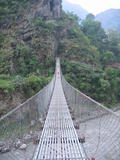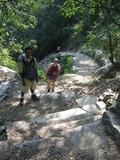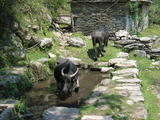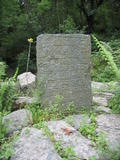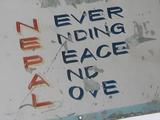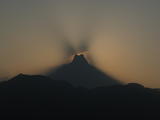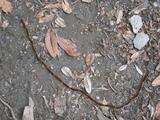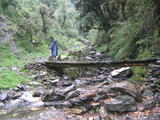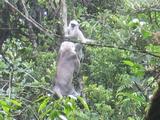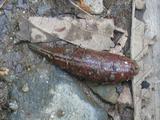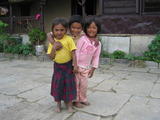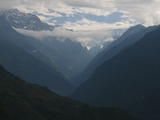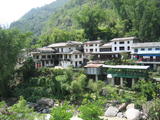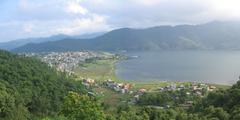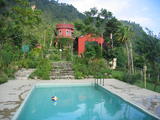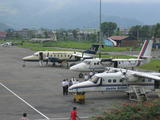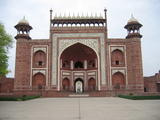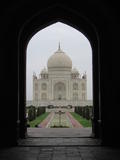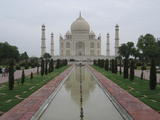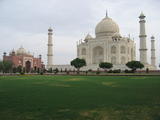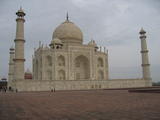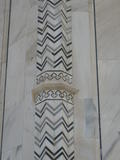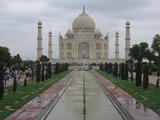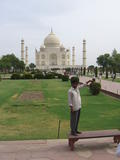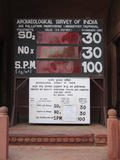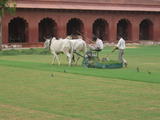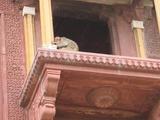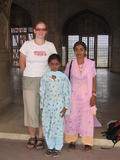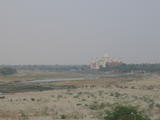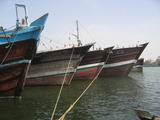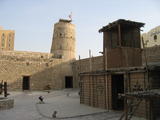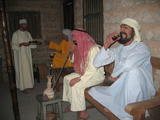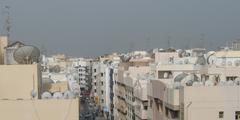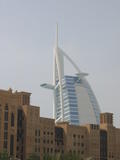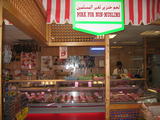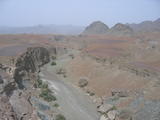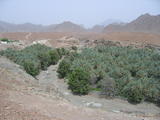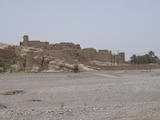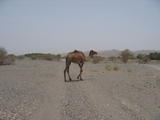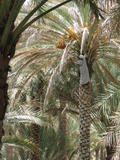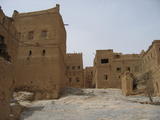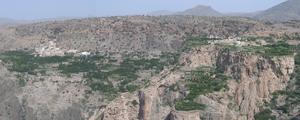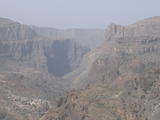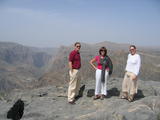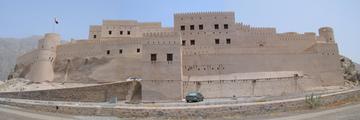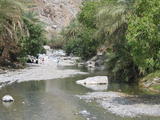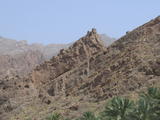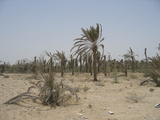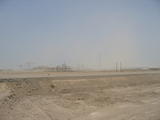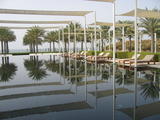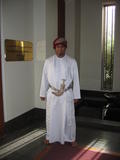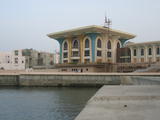| < < < Previous story | Next story > > > | |
Nepal, India and ArabiaNetherlands, 19 October 2005
Contents:Scare in the AirSeconds after taking off from Kolkata airport, the airplane motors suddenly powered down. A few seconds later they came back just to power down again. It was as if the pilot could not keep them going at full throttle! We heard strange noises and felt vibrations, as if something was loose or open. Then the plane started to loose altitude, which is not something it should be doing during take-off! I feared that the engines were not working properly and mentally pictured us crashing into the ground! After a few minutes the pilot addressed us over the intercom, he made a short pause that seemed to last minutes, before telling us that one of the wheels did not retract. I felt immediate relief as it explained the noise, vibrations and also explained why the airplane was flying lower than it should. He finished his announcement by stating that we had to return to Kolkata because the wheel would cause too much turbulence and increase fuel consumption. This was going to cost us at least a few hours more in Kolkata, something I was definitely not looking forward to as I just wanted to get to Nepal. Fortunately a few minutes after turning the plane back towards Kolkata, the pilot announced that he had succeeded to pull in the wheels and that we were going to fly to Kathmandu anyway. During the flight I kept on hoping that the wheels would also come out when we needed to land. They did, and besides the firetruck waiting for us at Kathmandu airport the rest of the flight was uneventful. We still managed to enjoy the executive class seats which we had taken because economy class was full. Al least if we had crashed we would have crashed in style! Welcome to NepalOut of the 14 mountains of over 8,000 meters in the world, 8 are in Nepal. They also happen to be 8 out of the 10 highest. Nepal has always been a popular traveler destination, but with the current Maoist uprising and the King's power grab the country is in turmoil. As a result Western countries have issued travel warnings to their citizens. However careful research on the Internet and feedback from other travelers made us believe that there was really nothing to fear. A conclusion which, after having visited the country, I feel was more than warranted as neither party in this low intensity civil war targets foreigners. We settled for a few days in Thamel, an area of Kathmandu popular with travelers, before heading out to Pokhara. In Kathmandu we got our first taste of yak cheese in a sandwich shop near our hotel. No-one I ever met really liked yak milk so I was kind of surprised that yak cheese tasted so good. During those days in Kathmandu we also got on a so-called Everest flight, which I thought was somewhat disappointing as we never got close to the mountain. In my opinion it is entirely overrated and a total waste of money. PokharaIn Pokhara the military are patrolling the streets and there are many checkpoints. However while locals are practically strip searched the occasional tourist barely gets a glance from the soldiers, although they may return a frosty "hello" if you issue one. However when crossing into trekking territory which happens to be largely controlled by the Maoist, the military will eagerly check your trekking permit as this is the last place where they can do it. Cows and bulls roam the streets in Pokhara, sometimes lying in the middle of a street blocking entire lanes. The animals roam the countryside as well. One wonders who they belong to. Apparently these animals find their way back home by themselves each night. There were very few tourists. Still many restaurants and travel agents were open in the area of town called Lakeside. It was of course out of season, but there are also additional troubles including the fact that most western countries have issued travel warnings calling on their citizens to postpone all non-essential travel to Nepal. Mark, our Australian travel companion with whom we had visited Bangladesh was still with us. We took a taxi up Sarangkot and walked around the top and all the way back down to Pokhara (we were later told this was dangerous because of thugs in the area). At the top we had watched a few paragliders, this inspired us to try it too. The next day Mark did a tandem flight with the instructor. From the top it seemed they were going down fast, but they still managed to make it a 30 minute flight. The next day was my turn and since I weigh at least 30 kilos less than Mark we actually went up and flew over our take-off spot. It was exiting, I felt free as a bird, being held in the air by thin cords attached to some nylon or polyester cloth! With my camera in one hand trying to take photos of the ground and the birds, everything was moving in different directions. It was too much. I started to feel a bit sick. I knew I shouldn't have been taking so many pictures. Suddenly I had to throw up! I leaned over to one side just in time. So now you know why you should not live under a paragliding area! Back on Earth we went to a yoga and meditation class. I am not too sure about the meditation thing. Unfortunately we did not have enough time to pursue this activity. The highlight of our stay in Nepal was most certainly our six day trekking excursion to Tatopani, Poon Hill and Ghandruk. As soon as one leaves the road behind a whole new world opens up. Goods are carried by mules (or donkeys) or by people on their backs. As for us, we hired K.P., a guide who doubled as a porter. We packed as little as we could, which was still about 10 kilos between the two of us. K.P. carried this bag all the way. He was less tired than we were after a day of trekking! In the evenings we played card games with K.P. and during the trekking he had answers to nearly all of our questions about Nepal and the Himalayas. His English was excellent. I guess we were lucky with K.P. and this probably helped to make the whole experience memorable. I furthermore had purchased a good walking stick. So in spite of my walking problems I only had one blister in 6 days of near continuous walking. One particular day we walked for 12 hours (including several breaks) and ascended 1700 meters! Some of the highlights of our trek were the hot springs in Tatopani, seeing the sun rise behind Fishtail mountain from Poon Hill, the many leeches on the path from Ghorepani to Tadapani and the incredible view of the mountains from Ghandruk. Trekking in the Himalayas has definitely been one of the most beautiful experiences we had. Away from all the traffic noise, away from all the facilities of modern life, away from the Internet, really away from it all, like traveling used to be! Walking between the most majestic mountains on Earth! One can only love this. Unfortunately these may be the last years to experience this as the government is planning to build a road all the way to Jomson. When we were there the road had been built to Tiplyang, a 3.5 hour walk from Tatopani. I can't imagine anybody wanting to trek along side a road, as this beautiful valley will be filled with noise and kicked up dust from the road. What a shame. Leaving NepalAfter 3.5 weeks in Nepal, we unfortunately had to leave. Nepal is a country were I would gladly have spent another 3 months! If only to do the entire Annapurna trek and follow some more yoga classes, I would even indulge myself in trying some more meditation classes. But alas we had other plans as well as flights that were fixed. The next 2 weeks we would be speeding from city to city across several countries, 2 days back in India, 2 days in Dubai and 8 days in Oman before heading back home. While flying from Kathmandu to New Delhi, we saw the beautiful Himalayas in the distance and I could only think; "When can I go back?" Taj MahalOur short stop in India was to visit the Taj Mahal. It would be hard to imagine leaving the subcontinent without seeing the Taj. It is certainly a beautiful sight of which I took photos of from every angle. The Taj was built by Shah Jahan (1628-1658) whose favorite wife Mumtaz died in 1631. It was a monument to his love for the only one of his four wives to bear him children. It took 22 years to build the Taj and in doing so Shah Jahan nearly ruined his country. Everything in and around the building is in perfect symmetry. Her grave is in the center of the building. However when Shah Jahan himself died his grave was placed next to hers, breaking the symmetry of the place. A black marble Taj Mahal was allegedly planned on the other side of the river to be Shah Jahan's own grave. The two were to be connected by a bridge but this was never realized as one of his sons deposed him, before any serious work could be started. Shah Jahan spent the rest of his years imprisoned in Red Fort with a view of the Taj Mahal... ArabiaOur stay in Dubai was short as well, we spent just two nights, visited the museum and walked around the city a bit. It was very warm so we escaped the heat by visiting shops and the museum. The area where we stayed is known as Little India, and for good reason, we only saw Indians, Bangladeshis and Pakistanis. It felt as if we were still in India, but for the fact that the town was clean and traffic organized. In fact only about 20% of the population of the U.A.E. are Emiratis (or however you are supposed to call nationals of the U.A.E.). The rest of the population consists of immigrant workers. Could we be visiting Arabia without seeing any Arabs? My aunt and uncle currently live in Sohar in neighboring Oman. As we wanted to visit them as well they came to pick us up in Dubai. This was a very nice thing of them to do. It was also the first time in months that we sat in a decent car and drove over a real highway and if it weren't for the heat, the lack of vegetation along the road and the occasional Arab in a white dress, we could have imagined ourselves back home. While 200 kilometers in India or Nepal will take you at least 6 hours of arduously slow travel by bus, in the U.A.E. and Oman it means just a short 2 hour drive. And so it was a short two hour drive later that we found ourselves in Sohar, in yet another country. With temperatures in the 40s (Celsius) even tap water was too warm. So people switch off the boiler and use it to cool water to room temperature (rooms are always air-conditioned). This has the curious effect that "cold" water comes out of the warm water tap while warm water comes out of the cold water tap... at least in summer. It surprised me somewhat that it was actually possible to walk outside when it was 44 degrees Celsius, not for long, but it was. In a way we were quite tired of the last few months of traveling which combined with the high temperature made us a bit lazy. It was barely feasible to visit anything because of the heat. Fortunately we did manage to visit Jebel Akhbar, which at 2000 meters was somewhat cooler, and on our way we visited a few castles and drove through some wadis. A wadi is a dry river bed. Since there is hardly any water these dry river beds are often used as parking places. However every once in while it does rain and whoever hasn't gotten his car out of the wadi will lose it... let's call it Omani roulette! We definitely chose the wrong season to visit Oman. On the other hand experiencing 44 degrees Celsius is something to write home about as well. Returning HomeWe flew from Muscat to Brussels via London on the 8th of July, one day after the bombings in the London underground. It's just bizarre but when we returned from South America to Europe in 2004 it was via Madrid on the 10th of March, one day before the Madrid bombings! Coincidence? Or should I start warning people of our flight plans? Strangely enough, everything in Heathrow functioned well, there were no delays and we were not unduly harassed by security staff. Except for the TV screens in Heathrow showing endless footage of the bombings everything else seemed to be business as usual. Got to hand it to the Brits, they do not overreact. If you would like to be notified or no longer want to be notified of our travel updates please e-mail me. e-mail Otto de Voogd PhotosNepalTaj MahalDubaiOmanPractical Information
To my knowledge the information provided here was accurate
at the time of our visit. However time passes and things can change.
VisasAs applied to us, holders of Dutch passports:
Nepal: Upon arrival 60 days for 30 USD and 1 passport photo.
Money
Nepal:
Many ATMs, but not all, work for cards on the Maestro and Cirrus networks.
Indian Rupees are accepted for payment in shops at the rate of
100 Indian Rupees to 160 Nepali Rupees. However possession of large
denomination Indian banknotes (500 and 1000 INR) is illegal in Nepal.
Flights (for foreigners) are in USD, but can be paid in NPR
(usually at a reasonable exchange rate).
TravelAirlines in Nepal that we used:
Internet, Bookshops and Travel AgentsInternet in Nepal is (sometimes frustratingly) slow compared to India. However there are plenty of bookshops and travel agents in tourist areas. In Oman it was more difficult to find Internet access. CostsNepal - Rupee, Approx. rates: 1 USD = 70 NPR, 1 EUR = 85 NPR. The Nepali Rupee is pegged to the Indian Rupee at 100 INR = 160 NPR.
Flight: Kolkata -> Kathmandu with Indian Airlines: 130 USD + 17.50 USD tax.
Executive class, economy was full and would have cost 110 USD plus tax.
Trekking:
Flight: Pokhara -> Kathmandu: 40 USD incl. tax (plus 169.50 NPR airport tax)
with Cosmic Air.
It may be hard to imagine but as no travel agent offered the cheap flight in
Pokhara, while several did in Thamel, we bargained over the price
(which was still more than twice the local rate) and were determined
to take the bus if we could not get it for this price.
It turned out 10% lower than the what we paid from Kathmandu to Pokhara
and significantly less than the official rate of 67 USD.
India - Rupee, approx. rates: 1 USD = 44 INR, 1 EUR = 56 INR
Delhi Airport Bus, City Coach Service: 50 INR
United Arab Emirates - Dinar, Approx. rates: 1 USD = 3.67 AED, 1 EUR = 4.43 AED. The U.A.E. Dinar is pegged to the U.S. Dollar.
Dubai: Hotel San Marco: 30.40 EUR per night reserved through an Internet
hotel room vendor.
Oman - Rial, Approx. rates: 1 USD = 0.385 OMR, 1 EUR = 0.46 OMR. The Omani Rial is pegged to the U.S. Dollar at the rate of 1 OMR = 2.60 USD. Jebel Akhdar: Jebel al-Akhdar Hotel: officially 29.500 OMR, but a small discount is possible. Staying at this hotel is the only way to get a permit to visit Jebel Akhdar independently. | ||
| < < < Previous story | Next story > > > | |
New | About | Contact | Connect | Friends | Promotions | Copyright | Advertise
